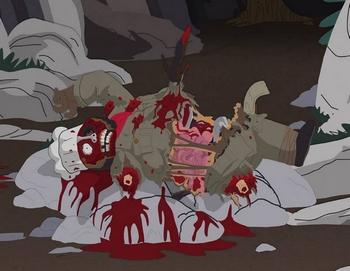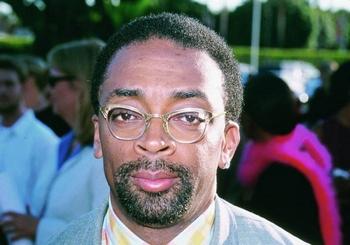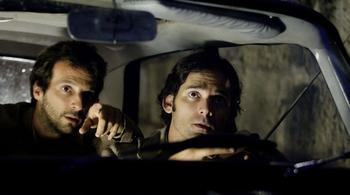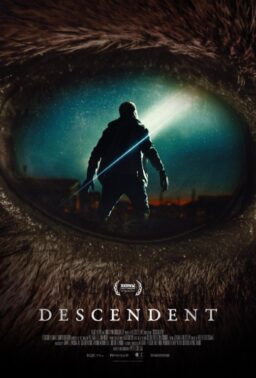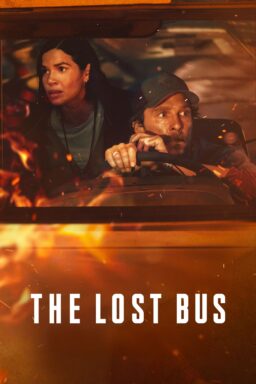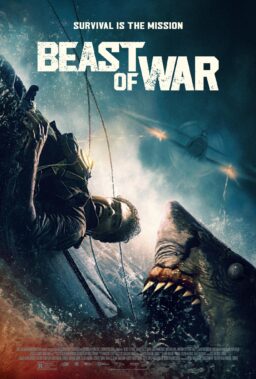NOTE: Reader Cameron Smith has noticed that this shot has been cropped for the DVD version of the film. See his explanation here.
Although I enjoyed certain aspects of “The Dark Knight” (especially the gorgeously real Chicago cityscapes, which I thought stole the movie out from under even Heath Ledger), I have confessed I couldn’t tell what was supposed to be going on from one moment — often one shot, or one line — to the next, and, for that very reason, soon stopped caring. Now that I’ve been able to go through it several more times since its release on DVD and Blu-ray last month, and have cross-checked the movie itself with the screenplay for clarification (it’s available as a .pdf here, For Your Consideration), I’m able to better understand exactly why. And it’s not just me. Now, at last, we have the means to really look past the phenomenon directly at the picture, and to understand how it works. Or doesn’t.
Let me start by asking you to examine one simple, minor early example that has to do with narrative logic and, perhaps, setting up the audience’s willingness to suspend disbelief in a comic book universe rendered with hyper-realistic visuals (even, occasionally, in IMAX): Please watch the shot above, the final piece in the opening sequence, showing the Joker’s escape from the “mob bank” robbery and giving us our first “overview,” if you will, of the scene. The Joker has backed a school bus into the lobby of a bank, filled it with mob cash, and then makes his exit.
After the jump is the script’s description of the shot. But before you read it, please leave a comment with your account of the shot AND your assessment of how the Joker planned this getaway. Pay special attention to the timing (dust/debris, busses, traffic signal, arriving cop cars). Ready? Begin.
Just to give you an idea of the translation from script to screen, this is the description of the action on page 6 of the script by Jonathan Nolan and Christopher Nolan (story by Christopher Nolan & David S. Goyer):
The School Bus pulls free of the Bank wall and pulls out onto
the street, SLIDING INTO THE LINE OF IDENTICAL BUSES HEADING
PAST THE BANK. The buses trundle past COP CARS racing up the
street…
We’ll continue this in the comments…
UPDATE: … but first perhaps further introduction/explanation is necessary: People have been debating for months about the phenomenally popular “TDK,” arguing that it is “incoherent” or “not incoherent” or “more incoherent on second viewing” or “less incoherent on second viewing” or “incoherent but it doesn’t matter” or “incoherent on purpose because the Joker is an agent of chaos” or whatever. So, I thought I’d start with a small example of what I find so disappointing about the film (and plausibility is the least of it, though it defies its own rules of plausibility from moment to moment… possibly because the Joker is an agent of chaos and therefore wily and unpredictable, except when he isn’t, which is part of the unpredictable part, because he absolutely insists that he is mayhem-y and anarch-ish, but maybe he’s not telling the truth about that, either).
I like what Stephanie Zacharek says about the film at Slate Movie Club, and I want to get into the specifics of what she describes — not to pick the movie apart, but to explain what cinematic coherence means, and why it matters. It’s a bad flawed movie in many ways, but its impact has made it an Important Bad Flawed Movie — and as much (or more) can be learned from a bad flawed movie as from a good great one:
Regarding “The Dark Knight“: Since I’ve already written at length on it elsewhere, I’ll be brief here, but I don’t find it visually dazzling or inventive–just murky. And I find Nolan’s images (even the ostensibly dazzling ones) disconnected from one another and from any meaningful, overarching whole. I’m baffled that a filmmaker who claims to love Hitchcock would be so clueless about visual storytelling: Nolan relies on a lot of expository dialogue to explain what’s going on, which I guess is a good thing, because I wouldn’t want to have to figure out what this thing is about based solely on the visuals or the editing. I found watching Heath Ledger‘s performance very sad: It’s a good performance, not a great one (it’s repetitive, building or stretching toward nothing), and I’m sorry he’s not around to give us some better ones, as I’m sure he would have. I fail to find any political or even emotional resonance or depth in the whole exercise.

